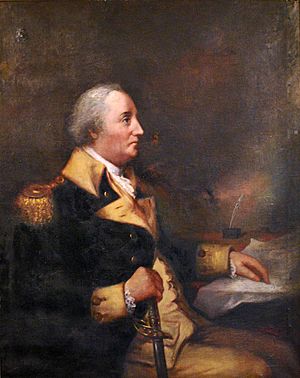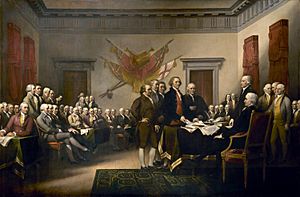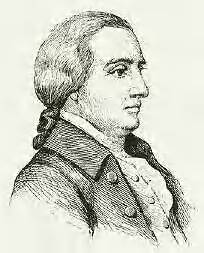William Whipple facts for kids
Quick facts for kids
William Whipple
|
|
|---|---|

Posthumous portrait by Walter Gilman Page
|
|
| Born | January 14, 1730 Kittery, Massachusetts Bay (now Maine), British America |
| Died | November 28, 1785 (aged 55) New Hampshire, U.S. |
| Allegiance | |
| Service/ |
|
| Rank | |
| Commands held | New Hampshire Militia (Bellow's Regiment of Militia, Chase's Regiment of Militia, Moore's Regiment of Militia, Welch's Regiment of Militia) |
| Battles/wars | American Revolutionary War |
| Spouse(s) | Catherine Moffat Whipple |
| Signature | |
William Whipple (born January 14, 1730 – died November 28, 1785) was an important person in early American history. He was one of the Founding Fathers and signed the United States Declaration of Independence. He represented New Hampshire in the Continental Congress from 1776 to 1779. Before becoming a politician, he worked as a ship's captain and a merchant. Later in life, he became a judge. He passed away at the age of 55 due to heart problems.
Early Life and Education
William Whipple was born in Kittery, which was then part of Massachusetts Bay (now Maine). His parents were Captain William Whipple Sr. and Mary Cutt. He went to a regular school for a while.
When he was young, William decided to go to sea. By the time he was 21, he became a ship's master, meaning he was in charge of a ship. In 1767, he married his cousin, Catherine Moffat. They moved into the Moffatt-Ladd House in Portsmouth in 1769. Sadly, their son, William Whipple III, died when he was a baby.
Whipple became wealthy through trade, shipping goods like wood and rum. In 1759, he started a merchant business in Portsmouth with his brother, Joseph.
Political Career
In 1775, the people of New Hampshire decided to create their own government, separate from British rule. They formed a House of Representatives and an Executive Council. William Whipple was chosen to represent Portsmouth in this new government. He also joined the Committee of Safety, which helped protect the people during the American Revolution.
Later, he was elected to the Continental Congress. This was a very important group of leaders from the American colonies. As a member, he signed the United States Declaration of Independence, a document that declared America's freedom from Britain. His second cousin, Stephen Hopkins, also signed the Declaration.
In January 1776, Whipple wrote a letter to his friend and fellow signer, Josiah Bartlett. He said that the year would bring big changes for America. He believed that the future of the country depended on the courage of its people. He felt that if they were brave enough to fight for freedom, they deserved its blessings.

William Whipple strongly believed in freedom for everyone. He made the important decision to free his own servant, Prince Whipple. He felt that no one could truly fight for freedom while keeping another person enslaved.
He wrote about his hope that freedom would spread to all people in America. He believed that freeing enslaved people would help bring the blessings of liberty to everyone.
Military Service
In 1777, the New Hampshire Provincial Congress gave William Whipple his first military command. During the Saratoga campaign, he led a group of four militia regiments. These regiments included Bellow's, Chase's, Moore's, and Welch's.
Whipple and Colonel James Wilkinson were chosen by Major General Horatio Gates to discuss surrender terms with General John Burgoyne of the British army. This happened after the American victory at the Battle of Saratoga. Whipple then signed the agreement that led to General Burgoyne and his troops surrendering. This was a huge victory for the Americans.
After the surrender, Whipple helped escort Burgoyne's army to Winter Hill, Somerville, Massachusetts. Whipple also shared the news of the Saratoga victory with Captain John Paul Jones. Jones then told Benjamin Franklin, who was in Paris at the time. This news was very helpful to Franklin as he worked to form an alliance with the French.
In 1778, Whipple joined General John Sullivan at the Battle of Rhode Island. There, he commanded several regiments, including Evans', Peabody's, and Langdon's light horse regiment. During the battle, after General Sullivan ordered a retreat, Whipple and other officers were in a house nearby. An enemy cannonball hit a horse outside and badly wounded one of Whipple's officers.
Later Life and Death
After the war ended, William Whipple became a judge. He served as an associate justice on the Superior Court of New Hampshire.
He had a heart condition. One day, while traveling for his court duties, he fainted from his horse and died. He was 55 years old. William Whipple was buried in the North Cemetery in Portsmouth, New Hampshire. In 1976, for the United States Bicentennial, his original headstone was replaced with a new memorial.
See also
 In Spanish: William Whipple para niños
In Spanish: William Whipple para niños



